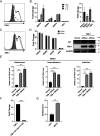TIM-1 Augments Cellular Entry of Ebola Virus Species and Mutants, Which Is Blocked by Recombinant TIM-1 Protein
- PMID: 35384693
- PMCID: PMC9241846
- DOI: 10.1128/spectrum.02212-21
TIM-1 Augments Cellular Entry of Ebola Virus Species and Mutants, Which Is Blocked by Recombinant TIM-1 Protein
Abstract
Ebola virus, a member of the Filoviridae family, utilizes the attachment factors on host cells to support its entry and cause severe tissue damage. TIM-1 has been identified as a predominant attachment factor via interaction with phosphatidylserine (PS) localized on the viral envelope and glycoprotein (GP). In this study, we give the first demonstration that TIM-1 enhances the cellular entry of three species of Ebola virus, as well as those harboring GP mutations (A82V, T544I, and A82V T544I). Furthermore, two TIM-1 variants (i.e., TIM-1-359aa and TIM-1-364aa) had comparable effects on promoting Zaire Ebola virus (EBOV) attachment, internalization, and infection. Importantly, recombinant TIM-1 ectodomain (ECD) protein could decrease the infectivity of Ebola virus and display synergistic inhibitory effects with ADI-15946, a monoclonal antibody with broad neutralizing activity to Ebola virus. Of note, EBOV strains harboring GP mutations (K510E and D552N), which were refractory to antibody treatment, were still sensitive to TIM-1 protein-mediated impairment of infectivity, indicating that TIM-1 protein may represent an alternative therapeutic regimen when antibody evasion occurs. IMPORTANCE The viral genome has acquired numerous mutations with the potential to increase transmission during the 2013-to-2016 outbreak of Ebola virus. EBOV strains harboring GP mutations (A82V, T544I, and A82V T544I), which have been identified to increase viral infectivity in humans, have attracted our attention. Herein, we give the first report that polymorphic TIM-1 enhances the infectivity of three species of Ebola virus, as well as those harboring GP mutations (A82V, T544I, and A82V T544I). We show that recombinant TIM-1 ECD protein could decrease the infectivity of Ebola virus with or without a point mutation and displays synergistic inhibitory effects with ADI-15946. Furthermore, TIM-1 protein potently blocked cell entry of antibody-evading Ebola virus species. These findings highlight the role of TIM-1 in Ebola virus infection and indicate that TIM-1 protein represents a potential therapeutic avenue for Ebola virus and its mutated species.
Keywords: Ebola virus; recombinant TIM-1 protein; variant surface glycoprotein.
Conflict of interest statement
The authors declare no conflict of interest.
Figures






References
-
- Olejnik J, Forero A, Deflubé LR, Hume AJ, Manhart WA, Nishida A, Marzi A, Katze MG, Ebihara H, Rasmussen AL, Mühlberger E. 2017. Ebolaviruses associated with differential pathogenicity induce distinct host responses in human macrophages. J Virol 91:e00179-17. doi:10.1128/JVI.00179-17. - DOI - PMC - PubMed
Publication types
MeSH terms
Substances
LinkOut - more resources
Full Text Sources
Medical

